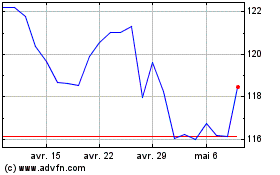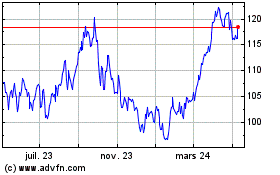Oil Slump Sets Scene for Mergers
28 Janvier 2016 - 11:41PM
Dow Jones News
By Bradley Olson and Sarah Kent
Here's how bad things are getting in the oil patch: In some
cases it is now cheaper for energy companies to buy one another
rather than drill for crude.
A year-and-a-half on from the start of the worst crude-oil price
crash in a generation, the biggest U.S. and European energy
companies have delayed projects and made such deep budget cuts that
they will soon struggle to replace the oil they pump out of the
ground with new reserves. That conundrum could have serious
implications for Exxon Mobil Corp., BP PLC, Chevron Corp. and Royal
Dutch Shell PLC because oil-and-gas reserves are critical to
evaluating their growth prospects.
Exxon and its peers are set to begin reporting fourth-quarter
earnings this week, starting with Chevron on Friday. Analysts
estimate that combined profits at the four biggest publicly traded
Western oil companies will be about $22 billion, the weakest
results since 1998, according to S&P Capital IQ. Shell,
Chevron, Exxon and BP declined to comment.
Facing poor returns for drilling and severe challenges to
long-term growth, some big oil companies have little choice but to
turn to deals, said Anish Kapadia, an energy analyst at Tudor
Pickering Holt & Co.
"The obvious conclusion is to go out and buy something," he
said. "The valuations are getting quite attractive."
Past energy downturns drove many of the biggest oil companies to
strike deals, with big companies buying smaller rivals such as
Anadarko Petroleum Corp.'s takeover of Union Pacific Resources in
2000. Equally matched energy conglomerates also lashed themselves
together the last time oil traded in a $20-a-barrel range in the
late 1990s, including Exxon's tie-up with Mobil and Chevron's with
Texaco. Deal-making is likely to return this year if prices
continue to languish around $30 a barrel, or drop ever further,
analysts say.
"If prices stay this low, we're going to see much more
distressed companies and that will drive M&A," said Luke
Parker, research director at Wood Mackenzie. Then again, any signs
of a sustained recovery could also prompt an uptick in deals as
companies look to start spending again, he added.
Bankers and analysts have been predicting a wave of deals almost
since crude prices began to fall from over $100 a barrel in the
summer of 2014, but they never materialized. Last year was the
slowest year for oil-and-gas transactions in over a decade,
according to Wood Mackenzie. The average monthly deal count fell by
over a third compared with 2013 and 2014, with only 14 deals
announced with a value higher than $1 billion.
The only sizable acquisition by a big energy companies so far is
Shell's $50 billion purchase of BG Group PLC, which Shell and BG
shareholders approved this week and is expected to close in
February. The deal will boost Shell's oil-and-gas reserves by about
25% and increase its production by 20% to 3.7 million barrels of
oil equivalent a day.
Many U.S. oil producers that tap shale formations have fought
for a year to avoid a sale, including Apache Corp.--which fended
off an overture by Anadarko last fall--and Whiting Petroleum Corp.,
once the biggest producer in North Dakota's Bakken Shale, which
entertained offers last year before turning to Wall Street for more
debt and equity. Just as potential sellers were reluctant to accept
offers they considered too low as they hoped for a rebound in oil
prices, many potential buyers were also put off by the extreme
volatility in oil prices and wondered if any deal struck would look
expensive if crude prices fell ever further.
Both impediments are gone now that hopes for a quick rebound
have been dashed. Forecasters at most major banks and ratings firms
are predicting oil prices will average under $50 a barrel this
year, and a few energy economists now predict that oil prices could
stay low through 2017 and into 2018.
At current prices U.S. shale producers are losing more than $2
billion a week, according to consulting firm AlixPartners LLP. That
means as oil's crash grinds on, some shale companies may be forced
to fall into the arms of a willing buyer this year.
Oil-patch deals now look more attractive than they have in
years, said Robin Bertram, the oil-and-gas resource evaluation
leader at Deloitte LLP. That is especially true for some of the
biggest oil companies, which largely sat on the sidelines during
the U.S. shale boom.
"With the low price environment, you will see the economics
around drilling getting worse and worse," he said. "More companies
will be buying assets rather than continuing to develop."
Write to Bradley Olson at Bradley.Olson@wsj.com and Sarah Kent
at sarah.kent@wsj.com
(END) Dow Jones Newswires
January 28, 2016 17:26 ET (22:26 GMT)
Copyright (c) 2016 Dow Jones & Company, Inc.
Exxon Mobil (NYSE:XOM)
Graphique Historique de l'Action
De Juin 2024 à Juil 2024

Exxon Mobil (NYSE:XOM)
Graphique Historique de l'Action
De Juil 2023 à Juil 2024
